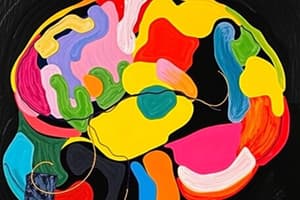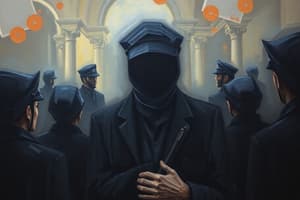Podcast
Questions and Answers
What thematic element prominently shapes the narrative in 'Fear' by Guy De Maupassant?
What thematic element prominently shapes the narrative in 'Fear' by Guy De Maupassant?
- The pursuit of wealth and status
- The conflict between civilization and nature
- The exploration of paranoia and human psyche (correct)
- The triumph of love over adversity
Which character dynamic is crucial to understanding the plot development in 'Fear'?
Which character dynamic is crucial to understanding the plot development in 'Fear'?
- An oppressive relationship with authority (correct)
- A complex romantic entanglement
- A rivalry between two friends
- A mentor-student relationship
What emotional response does the protagonist primarily exhibit throughout 'Fear'?
What emotional response does the protagonist primarily exhibit throughout 'Fear'?
- Confidence and assurance
- Indifference and detachment
- Panic and desperation (correct)
- Joy and satisfaction
In terms of narrative style, which technique is prominently used in 'Fear' to convey tension?
In terms of narrative style, which technique is prominently used in 'Fear' to convey tension?
What role does setting play in establishing the mood in 'Fear'?
What role does setting play in establishing the mood in 'Fear'?
Flashcards
Fear
Fear
A feeling of intense and often overwhelming dread, apprehension, or alarm, typically caused by a perceived threat or danger.
Guy de Maupassant
Guy de Maupassant
A French writer known for his short stories and novels, often exploring themes of human psychology, societal hypocrisy, and the darker aspects of life.
Realism
Realism
A literary genre that aims to depict life realistically, focusing on everyday characters and situations, often exploring social problems and individual psychology.
Imagery
Imagery
Signup and view all the flashcards
Theme
Theme
Signup and view all the flashcards
Study Notes
Summary of "Fear" by Guy de Maupassant
- The story centers on a unnamed narrator, who experiences a powerful and irrational fear of dying in public.
- The narrator's fear is triggered by a series of seemingly insignificant events.
- These events include witnessing a dead body, a sudden illness of a person, and the narrator's own imagined struggles with death.
The Triggering Events
- The narrator initially feels apprehension after witnessing a dead body in the hospital.
- He experiences a sudden outburst of panic while observing an acquaintance who appears pale and ill. This incident further cultivates the narrator's fear.
- The narrator begins to think obsessively about his own potential demise. He imagines the shame and humiliation of dying in public, and all these visions feed his growing fear.
- This includes his thoughts of being "caught" in the act of dying, the horror of a public struggle, and the eventual loss of dignity.
Manifestations of the Fear
- The narrator's fear manifests physically, producing symptoms like palpitations, shortness of breath, and a feeling of impending doom.
- The fear escalates to the point of debilitating the narrator.
- The fear becomes a constant and overwhelming presence in his life, hindering his enjoyment of normal activities and social interactions.
The Irrational Nature of the Fear
- The central theme is the irrationality of the narrator's fear.
- While there's no specific tangible threat, the emotional response and perceived public shame are the major drivers of his anxiety.
- The fear seems disproportionate to the circumstances.
- The author highlights the psychological impact of fear and the way it can manifest in the absence of real danger.
The Impact on Daily Life
- The narrator's fear limits his social interactions and enjoyment of everyday activities.
- He isolates himself due to the dread of facing possible public humiliation from his fear.
- The fear significantly alters his perception of social situations, even if they are ordinary.
Internal Conflict
- The story portrays an internal conflict, where the narrator struggles with his intense fear.
- He attempts to control and rationalize his fear, but his efforts are ultimately unsuccessful.
- This highlights the power of irrational fears to dominate and control thoughts and actions.
Conclusion
- The story suggests the pervasive impact of anxiety and fear on human behavior.
- It emphasizes the irrationality of fear and how an overwhelming sense of dread can negatively affect an individual's life.
- The story explores themes of self-consciousness, social anxiety, and the struggle against one's own anxieties and insecurities.
Studying That Suits You
Use AI to generate personalized quizzes and flashcards to suit your learning preferences.




